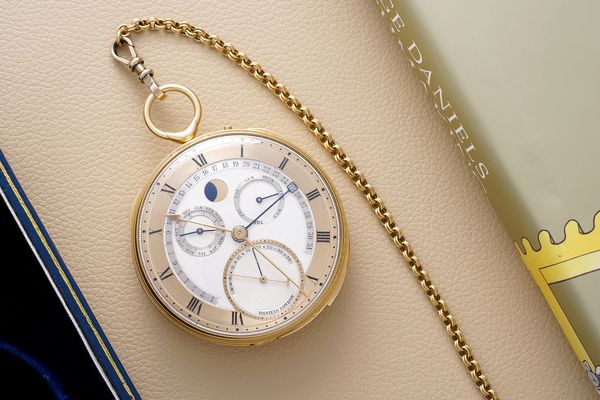- By Michael Clerizo
The Grand Complication is the first Daniels watch I held in my hands. It happened during a dinner with George and Roger Smith on the Isle of Man. It was in spring of 2002.
That was also the first time I met George. We’d talked on the phone and written letters to each other - George didn’t do email at the time, that only happened when he hired a secretary several years later - but we’d never met.
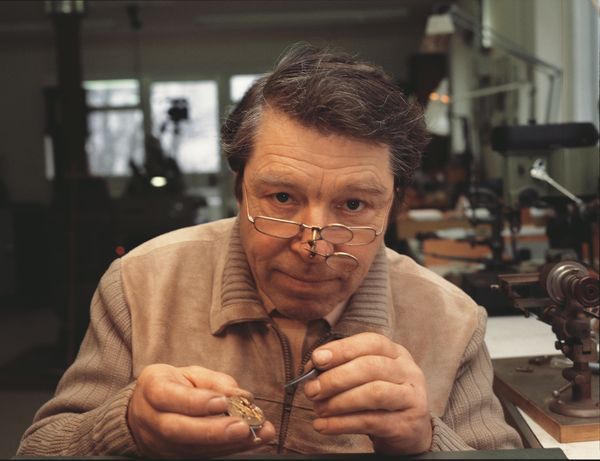
George could be intimidating when he first met someone not just because of his stature in the watch world but because he had an imperious manner. He could stare at you as if to say, ‘Exactly why are you bothering me? Aren’t you aware that I have better things to do then waste time with you.’ Once he got to know you and if he liked you George was charming and witty and a lot of fun to be with. Spending time with George was always an educational and entertaining experience.
I remember George complaining about the restaurant. He did not like the fact that there were no tablecloths on the tables. He told Roger who had made the dinner arrangements, ‘I like to eat in restaurants with tablecloths.’
He did not like the cutlery either, which he found flimsy, ‘I like heavy cutlery. I do not trust restaurants with cutlery that’s as light as paper. It makes me think the food will not be very substantial.’ All the while these preliminaries were taking place I stayed silent because I was fascinated by George’s waistcoat (vest for Americans). It was festooned with gold pocket watch chains. Roger told me that George often wore two pocket watches. Looking at the chains on his waistcoat. (I asked him to show me the pocket watch he was wearing. He immediately answered with ‘I’m wearing two and two wristwatches.’
It was then that George stretched his arms across the table and revealed a watch on each wrist. One was his four-minute tourbillon wristwatch, which he made in 1991 and the other was an Omega Speedmaster with a co-axial escapement.
Then he drew from one waistcoat pocket watch by the father of English watchmaking Thomas Tompion [1639 –1713]. Years later as my familiarity with George’s collection increased I knew this watch to be a quarter repeater with a verge movement. George opened the watch and I managed to identify the type of movement and the design of the hands as beetle and poker but completely missed the repeater mechanism. Still, George was mildly impressed. As I held the watch one thing attracted my attention that back of the case was not smooth. What to my fingers seemed like a series of bumps was a scene from Greek mythology – The Abduction of Helen by Paris. I said something that convinced George that the case back impressed me because he began a short lecture (something that was very common for George) on the many things lost to watch lovers after the shift from pocket watches to wristwatches, beautiful representation of events on case backs being one.
George did not have to say I’m saving the best for last but instinctively I knew that was his thinking. The second watch extracted from his waistcoat and handed to me was one of his own, The Grand Complication.

Any kudos gained from recognizing some features on the Tompion instantly disappeared after my first comment about the Grand Complication. in my hands two things struck me about the watch, it’s size and its weight. I said to George, ‘Wow, its big and heavy. You must have had to ask your tailor to reinforce the pockets on your waistcoat’. Big mistake! George’s eyes opened wide and glared at me through his glasses. So intense was George’s look that I thought of Superman melting metal with his x-ray vision.
‘I never had to ask my tailor to do anything special to my pockets,’ he said and immediately removed the watch from my hands and replanted it in his waistcoat.
George was quiet for a few minutes after that. Then the conversation drifted to the weather and car racing. I slightly redeemed myself towards the end of the meal by asking George to sign my copy of his book Watchmaking.
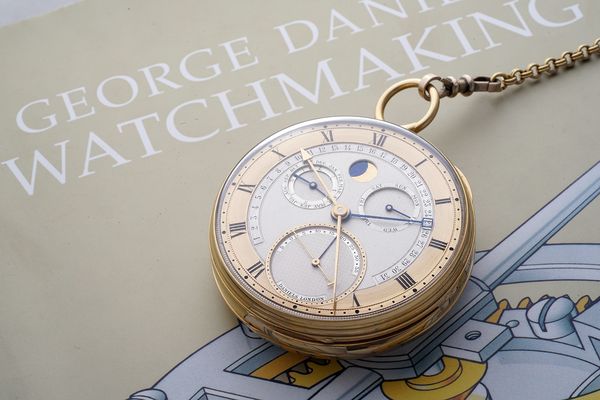
Happily, my faux pas did not affect the future of our relationship. I made my first visit to Riversdale George’s palatial home a few days later and he was the soul of hospitability preparing tea and cakes and showing me a number of watches in his collection. We kept in touch through letters and phone conversations and I often saw George when he was in London. He always invited me to the Isle of Man and the hospitality of Riversdale.
A few years later when I started my research for my book on George visits to Riversdale became more frequent and longer. It was during this time that my initially rocky relationship with the Grand Complication changed. Our days always started in Riversdale’s huge kitchen where breakfast was served by George’s helpers who were there to aid him in his day-to-day living.
We met in the kitchen a few minutes before breakfast, which was always a typically English: eggs, bacon, mushrooms and tomatoes. George would send me down into the basement where a vault – which George called a strong room - had been built to house his watch and clock collection. ‘Michael’, George would say, I want you to go down to the strong room and return to the kitchen with watches which we will discuss over breakfast.’

On some days he specified which watches I should return with. He’d tell me something like, ‘Bring up the Tompion, the Breguet Subscription, one of the Arnolds and a Daniels.’ If I asked which Daniels George answered with, ‘Anyone you like but make it one of the pocket watches.’
I descended to the strong room with a velvet-lined tray and returned to the kitchen with the selection for the day. We would sit at the table and discuss that day’s watches for hours. One of my abiding memories is sitting at that table with the man I believe to be the greatest watchmaker ever talking about watches by other great watchmakers while holding those watches in my hands – a few inches above my eggs, bacon, mushrooms and tomatoes.
Some days I returned to the kitchen table with the Grand Complication a watch that perfectly illustrates George’s approach to watchmaking.
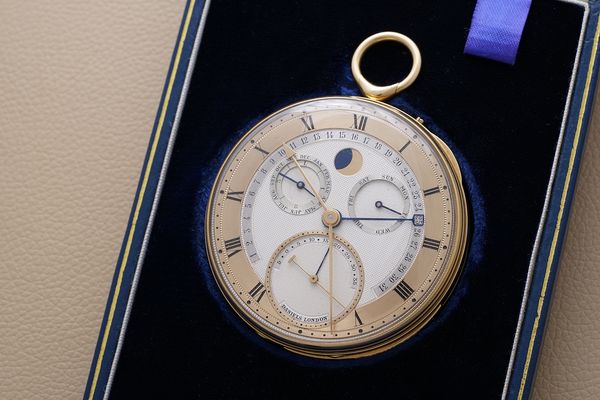
The key words in all George’s talk about making a watch were homogeneity, simplicity and elegance. George did a few preliminary drawings for all his watches, almost always of the dial, because once the dial arrangement was settled he know how he had to construct the movement. Ultimately he believed that those three highly desired characteristic were achieved in the workshop.
Take homogeneity – it’s about two things, color and proportion. George gilded his movements by hand and every gilded component had to have the same shade of gold. Polished steel components like wheels had to have the same shade of gunmetal grey. Same thing for stainless steel components they all had to have the same color and the same sheen. George blued screws over an open flame and all of them have the very same dark blue color.
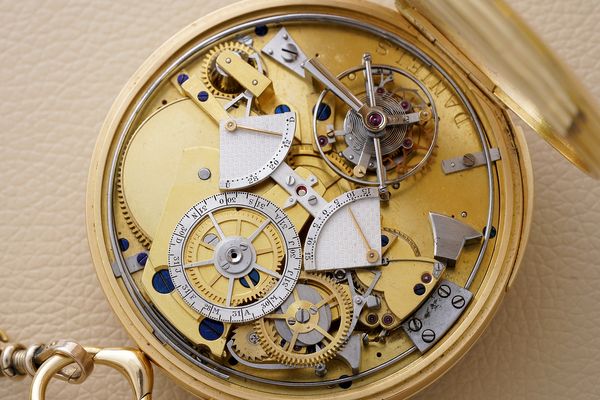
It was also important for George that the gold of the case blended well with the gilding on the movement. Obviously the case and the gilded movement components could never be the same shade of gold but they had to blend in a visually pleasing way.
The second key thing about homogeneity is proportionality. No matter what the size of a spring there was a right size for the screw that held the spring in place. For larger components like plates the same idea applied. He had to find the right size for the screws that held the plate in place. For George there was no question of using standard parts that could be bought. He made everything himself so the right size for components was something he settled at the workbench.
Another point about homogeneity, which is particularly evident on Grand Complication, is the proportions of the hands and the dial. The dial is a perfectly harmonious medley of circles all of them and the chapter rings are just the right size. The same thing is true of the hands. To take things further as George did even the distance between the numerals and the names of the days of the week and the months George carefully worked out. If something did not look right, say one of the chapter rings, he’d consign it to a box he called his graveyard of imperfect parts and start again.
If you changed the dimensions of any component on George’s movements or any feature oh his dials the whole thing would look wrong.
Simplicity and elegance in some ways derive from homogeneity. For George simplicity meant nothing superfluous. The movement did not contain any component that was not absolutely necessary to its smooth function. The same is true of finish. George did not use Geneva Stripes or perlage. He thought both of those looked fussy and were unnecessary. As I’ve already said he gilded so he did not need to do those things.

He also insisted on simplicity for his dials because that guaranteed legibility. He achieved simplicity and legibility on the dial of the Grand Complication by decided to position two quadrants one for the power reserve and one for the equation of time on the back of the watch. All the information provided by the watch is easy to read. The two quadrants by the way are visible through another circle - the aperture on the case back.
Elegance for George was related to simplicity but was also partly about materials. He believed in gold cases and silver dials. The dials had to be engine-turned and so did sometimes the case backs and sides.
One aspect of elegance of the Grand Complication and some other Daniels pocket watches still astonishes me - the winding system. George did not like the traditional pendant, bow, crown and winding stem configuration he felt it dominated the design of the watch and detracted from its elegance. His first watches were key wound but after 1984 all his pocket watches feature another of his inventions - a keyless winding system. There is no crown or visible stem just a nearly circular bow which works just like a crown. A gentle tug positions a hidden winding stem ready for setting and winding the watch. Purely in mechanical terms the Daniels winding system is extraordinary but the design of the system reveals its maker’s obsession with elegance.
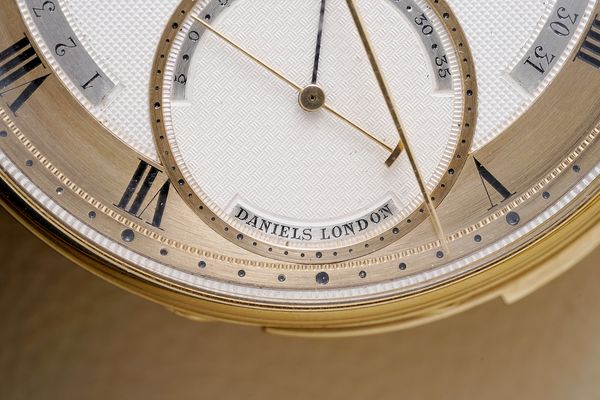
George also talked often about the need for naturalness in watches. He believed great watches appeared natural or created, not hand made. There was to be no evidence of the hand of the maker. He wanted his watches to look as natural as trees or flowers.
All four of these qualities homogeneity, simplicity, elegance and naturalness for George worked together. They reinforced each other. For him the end result was a beautiful watch and a beautiful watch was also the perfect machine for telling time.
Just one more thing, I said earlier that George is the greatest watchmaker who ever lived. Why? I have two reasons for saying that. The first is workbench skills. Through the history of watchmaking there are only a few people who were capable of such a feat. Even Tompion, Breguet and Arnold did little work at the bench once their business was established. George never stopped.

The second reason is influence. George’s style, which is classical and owes much to the watchmakers who came before him is not prevalent in the work of many watchmakers today. George’s work and his books especially Watchmaking convinced many young watchmakers that they could create their own watches.
The combination of those two qualities are what makes George Daniels the greatest watchmaker – ever.
